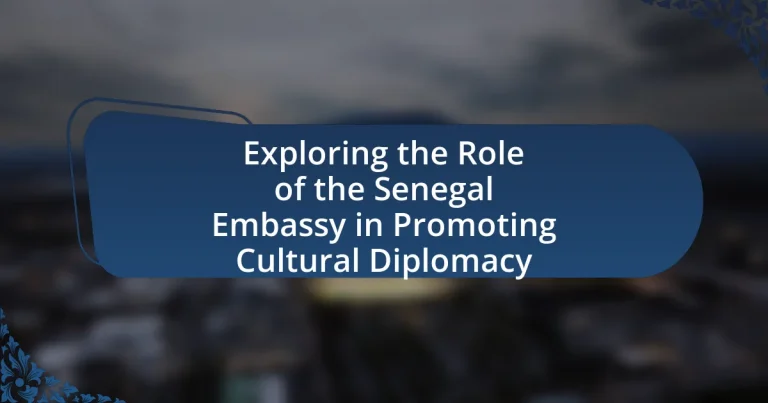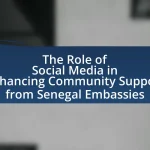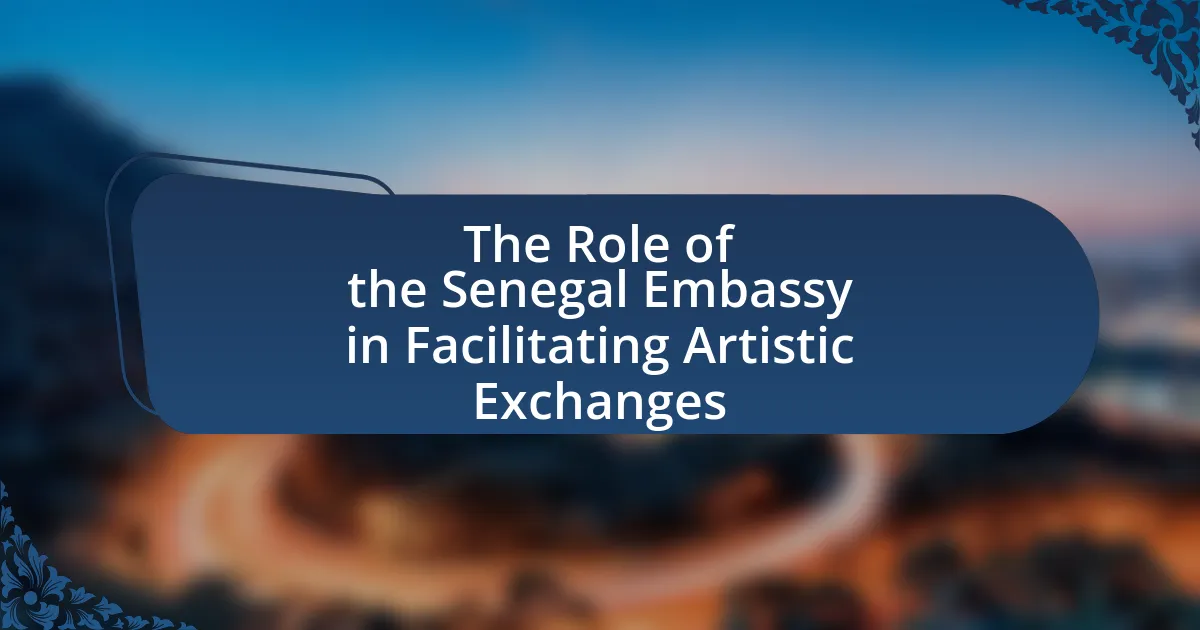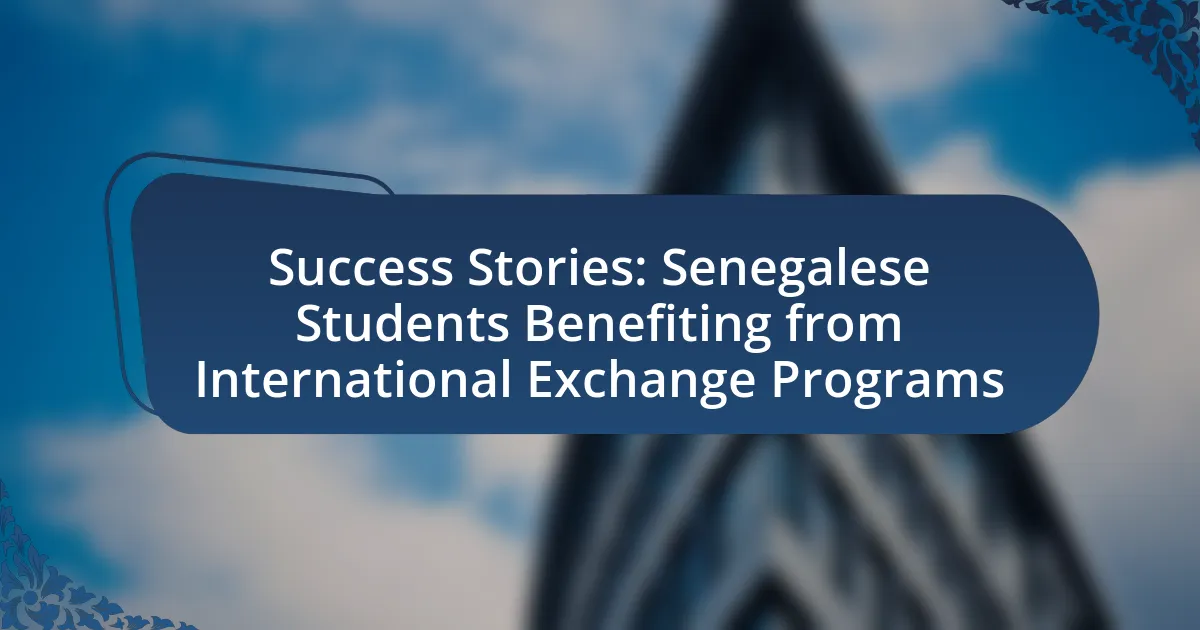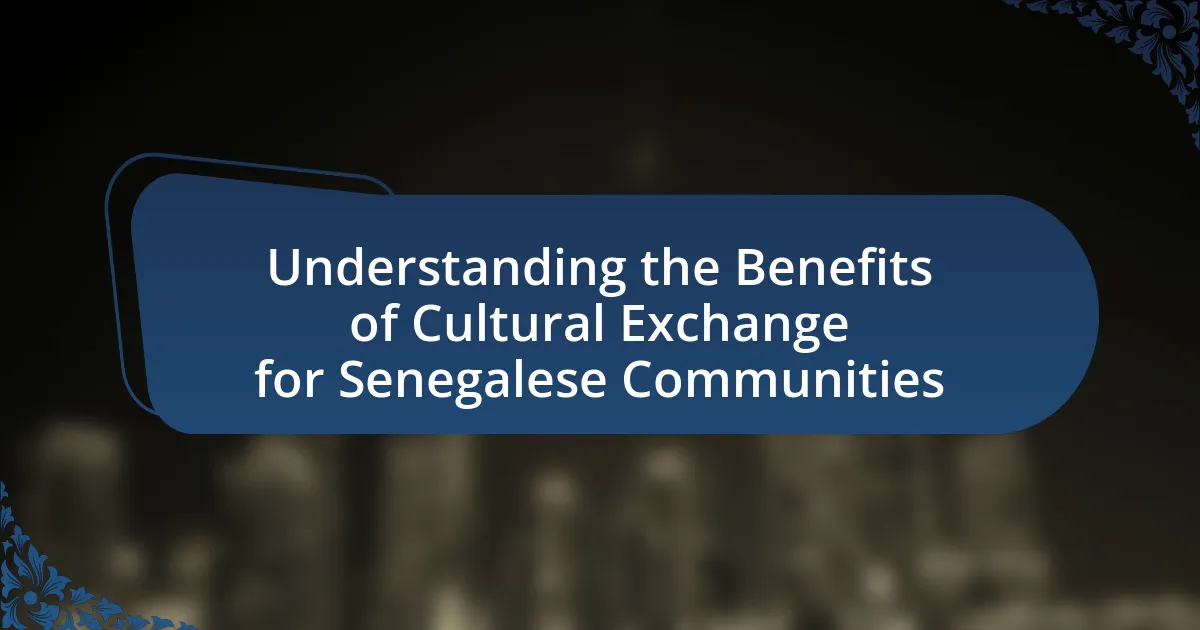The Senegal Embassy plays a vital role in cultural diplomacy by promoting Senegalese culture, heritage, and values on an international scale. Through organizing cultural events, exhibitions, and educational programs, the embassy fosters cross-cultural understanding and dialogue, while enhancing Senegal’s global cultural footprint. Key objectives include promoting Senegalese art, music, and cuisine, strengthening bilateral relations, and facilitating mutual respect among nations. The article also explores the challenges faced by the embassy, such as limited resources and language barriers, and discusses strategies for leveraging technology and community engagement to enhance cultural outreach efforts.
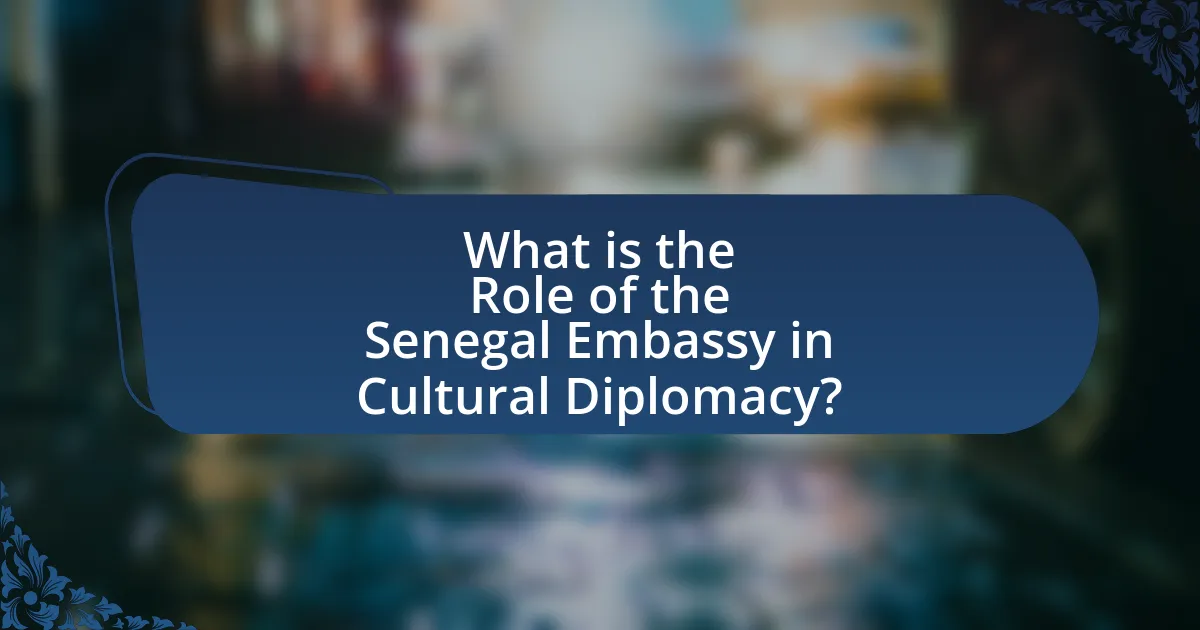
What is the Role of the Senegal Embassy in Cultural Diplomacy?
The Senegal Embassy plays a crucial role in cultural diplomacy by promoting Senegalese culture, heritage, and values internationally. This is achieved through organizing cultural events, exhibitions, and educational programs that showcase Senegal’s artistic traditions, music, and cuisine. For instance, the embassy often collaborates with local cultural institutions to host events that highlight Senegalese literature and visual arts, fostering cross-cultural understanding and dialogue. Additionally, the embassy serves as a platform for Senegalese artists and cultural practitioners to engage with global audiences, thereby enhancing Senegal’s cultural footprint abroad.
How does the Senegal Embassy define cultural diplomacy?
The Senegal Embassy defines cultural diplomacy as a means of fostering mutual understanding and respect between nations through the exchange of cultural values, traditions, and practices. This approach emphasizes the importance of cultural interactions in building relationships and enhancing cooperation on various global issues. The embassy actively engages in initiatives that promote Senegalese culture abroad, showcasing its heritage and facilitating dialogue that strengthens international ties.
What are the key objectives of cultural diplomacy for the Senegal Embassy?
The key objectives of cultural diplomacy for the Senegal Embassy include promoting Senegalese culture, enhancing bilateral relations, and fostering mutual understanding between Senegal and other nations. By showcasing Senegal’s rich heritage through art, music, and cuisine, the embassy aims to create a positive image of the country. Additionally, cultural diplomacy serves to strengthen diplomatic ties, as evidenced by initiatives such as cultural exchange programs and partnerships with local institutions, which facilitate dialogue and collaboration. These efforts contribute to a deeper appreciation of Senegal’s cultural diversity and its role in the global community.
How does cultural diplomacy differ from traditional diplomacy?
Cultural diplomacy differs from traditional diplomacy primarily in its focus on cultural exchange rather than political negotiations. While traditional diplomacy emphasizes formal agreements and state-to-state relations, cultural diplomacy seeks to foster mutual understanding and goodwill through cultural interactions, such as art, music, and education. For instance, cultural diplomacy initiatives often involve programs like cultural festivals or educational exchanges that aim to build relationships between nations at a grassroots level, contrasting with traditional diplomacy’s reliance on treaties and political discussions. This distinction highlights the role of soft power in cultural diplomacy, which can enhance a country’s image and influence without the coercive measures often associated with traditional diplomatic efforts.
Why is cultural diplomacy important for Senegal?
Cultural diplomacy is important for Senegal because it enhances the country’s international image and fosters mutual understanding through cultural exchange. By promoting Senegalese art, music, and traditions, the nation can strengthen its soft power and build strategic partnerships globally. For instance, Senegal’s vibrant music scene, exemplified by artists like Youssou N’Dour, has gained international recognition, showcasing the country’s cultural richness and attracting tourism. Additionally, cultural diplomacy facilitates dialogue and cooperation in areas such as education and development, contributing to Senegal’s socio-economic growth and stability.
What cultural values does Senegal aim to promote through diplomacy?
Senegal aims to promote values of peace, tolerance, and cultural diversity through its diplomatic efforts. The country emphasizes the importance of dialogue and mutual respect among different cultures, reflecting its historical role as a crossroads of various civilizations in West Africa. Senegal’s commitment to these values is evident in its participation in international organizations and cultural exchanges, which foster understanding and cooperation among nations.
How does cultural diplomacy enhance Senegal’s international relations?
Cultural diplomacy enhances Senegal’s international relations by fostering mutual understanding and cooperation through cultural exchanges and initiatives. The Senegalese government actively promotes its rich cultural heritage, including music, art, and literature, which helps to build soft power and strengthen ties with other nations. For instance, events like the Dakar Biennale showcase Senegalese art on a global platform, attracting international attention and collaboration. This cultural engagement not only enhances Senegal’s image abroad but also facilitates dialogue and partnerships, contributing to more robust diplomatic relations.
What strategies does the Senegal Embassy employ in cultural diplomacy?
The Senegal Embassy employs strategies such as cultural exchanges, partnerships with local artists, and participation in international cultural events to promote cultural diplomacy. These strategies facilitate mutual understanding and appreciation of Senegalese culture while fostering relationships with other nations. For instance, the embassy organizes art exhibitions and music festivals that showcase Senegalese heritage, thereby enhancing cultural visibility and engagement on a global scale.
What types of cultural events are organized by the Senegal Embassy?
The Senegal Embassy organizes various cultural events, including art exhibitions, music performances, film screenings, and culinary festivals. These events aim to promote Senegalese culture and foster cultural exchange. For instance, the embassy has hosted exhibitions showcasing traditional Senegalese art and music events featuring local artists, which serve to enhance understanding and appreciation of Senegal’s rich cultural heritage.
How does the Senegal Embassy collaborate with local and international artists?
The Senegal Embassy collaborates with local and international artists through various cultural programs and initiatives aimed at promoting Senegalese art and culture. This collaboration includes organizing art exhibitions, cultural festivals, and workshops that feature both local talents and international artists, fostering cross-cultural exchanges. For instance, the embassy has hosted events like the Dakar Biennale, which showcases contemporary African art and attracts global participation, thereby enhancing cultural diplomacy and visibility for Senegalese artists on the international stage.
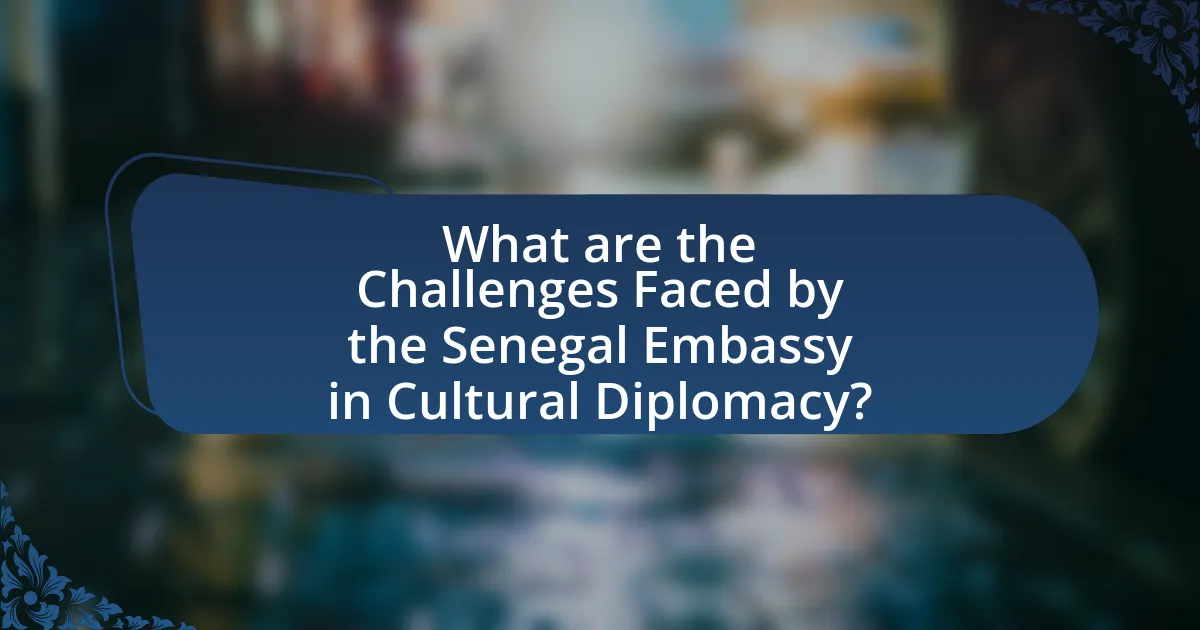
What are the Challenges Faced by the Senegal Embassy in Cultural Diplomacy?
The Senegal Embassy faces several challenges in cultural diplomacy, including limited resources, language barriers, and the need to effectively represent diverse Senegalese cultures. Limited funding restricts the embassy’s ability to organize cultural events and outreach programs, which are essential for promoting Senegalese heritage abroad. Language barriers can hinder communication and engagement with local communities, making it difficult to convey the richness of Senegalese culture. Additionally, the embassy must navigate the complexities of representing a nation with multiple ethnic groups and languages, ensuring that all voices are included in its cultural diplomacy efforts. These challenges impact the embassy’s effectiveness in fostering international cultural relations and promoting Senegal’s identity on the global stage.
What obstacles does the Senegal Embassy encounter in promoting cultural initiatives?
The Senegal Embassy encounters several obstacles in promoting cultural initiatives, primarily limited funding and resource constraints. These financial limitations hinder the embassy’s ability to organize events, collaborate with local artists, and effectively reach diverse audiences. Additionally, bureaucratic challenges and a lack of awareness about Senegalese culture in host countries further complicate their efforts, making it difficult to engage the community and foster meaningful cultural exchanges.
How do political factors influence cultural diplomacy efforts?
Political factors significantly influence cultural diplomacy efforts by shaping the priorities and strategies of diplomatic initiatives. For instance, government policies and international relations dictate which cultural exchanges are prioritized, often aligning them with national interests or geopolitical goals. An example is how Senegal’s government promotes its cultural heritage through initiatives that enhance its soft power, particularly in West Africa, to strengthen regional ties and attract foreign investment. This alignment of cultural diplomacy with political objectives demonstrates that political contexts can either facilitate or hinder the effectiveness of cultural outreach programs.
What role does funding play in the success of cultural diplomacy programs?
Funding is crucial for the success of cultural diplomacy programs as it directly influences the scope, reach, and effectiveness of these initiatives. Adequate financial resources enable the development and execution of diverse cultural events, educational exchanges, and collaborative projects that foster mutual understanding and strengthen international relationships. For instance, the Senegal Embassy’s investment in cultural festivals and art exhibitions not only showcases Senegalese heritage but also attracts global audiences, enhancing cultural exchange. Studies have shown that countries with robust funding for cultural diplomacy, such as Germany and France, have successfully increased their soft power and international influence, demonstrating the significant impact of financial support on the effectiveness of cultural diplomacy efforts.
How does the Senegal Embassy measure the impact of its cultural diplomacy?
The Senegal Embassy measures the impact of its cultural diplomacy through various metrics, including participation rates in cultural events, feedback from attendees, and partnerships with local organizations. By analyzing attendance numbers and collecting qualitative feedback, the embassy can assess the effectiveness of its programs in fostering cultural exchange. Additionally, collaboration with local cultural institutions provides insights into the reach and resonance of its initiatives, allowing for adjustments and improvements based on community engagement and response.
What metrics are used to evaluate the success of cultural events?
Metrics used to evaluate the success of cultural events include attendance numbers, participant demographics, audience engagement levels, and financial performance. Attendance numbers provide a quantitative measure of interest and reach, while participant demographics help assess the diversity and target audience engagement. Audience engagement levels can be gauged through surveys, social media interactions, and feedback forms, indicating the event’s impact on attendees. Financial performance, including revenue generated and costs incurred, offers insight into the economic viability of the event. These metrics collectively provide a comprehensive understanding of a cultural event’s success and its effectiveness in promoting cultural diplomacy.
How does feedback from participants shape future cultural initiatives?
Feedback from participants directly influences the design and implementation of future cultural initiatives by providing insights into their preferences, experiences, and suggestions for improvement. This feedback allows cultural organizations, such as the Senegal Embassy, to tailor programs that resonate more effectively with the community, ensuring greater engagement and relevance. For instance, surveys and focus groups conducted after cultural events can reveal what aspects participants enjoyed or found lacking, guiding adjustments in programming, marketing strategies, and resource allocation. By analyzing this data, the Senegal Embassy can enhance its cultural diplomacy efforts, fostering stronger connections between Senegal and its diaspora or host communities.
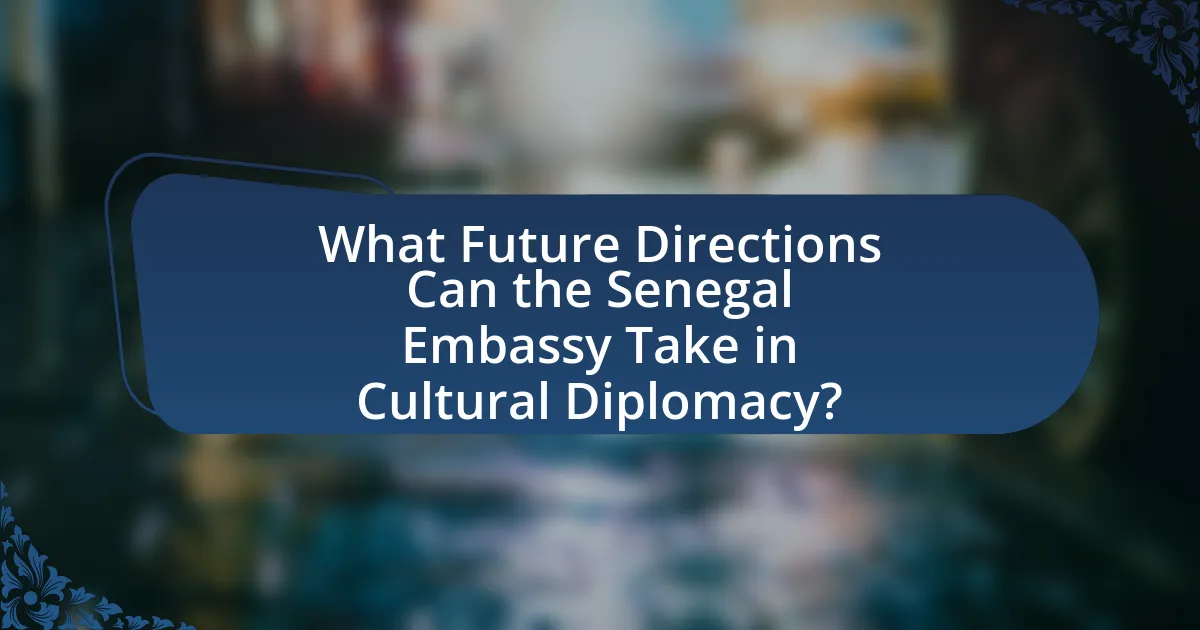
What Future Directions Can the Senegal Embassy Take in Cultural Diplomacy?
The Senegal Embassy can enhance its cultural diplomacy by fostering partnerships with local cultural institutions and promoting Senegalese art, music, and cuisine. By organizing cultural festivals and exhibitions, the embassy can showcase Senegal’s rich heritage, thereby increasing awareness and appreciation of its culture. For instance, the annual Dakar Biennale, which highlights contemporary African art, serves as a model for similar initiatives abroad. Additionally, the embassy can leverage digital platforms to reach a global audience, facilitating virtual cultural exchanges and collaborations. This approach not only strengthens bilateral relations but also positions Senegal as a key player in the global cultural landscape.
How can the Senegal Embassy leverage technology in cultural diplomacy?
The Senegal Embassy can leverage technology in cultural diplomacy by utilizing digital platforms to promote Senegalese culture globally. By creating virtual exhibitions, hosting online cultural events, and engaging audiences through social media, the embassy can reach a wider audience and foster cultural exchange. For instance, the use of live-streaming technology allows the embassy to showcase traditional Senegalese music and dance performances to international audiences, enhancing visibility and appreciation of Senegalese heritage. Additionally, the embassy can employ interactive websites and mobile applications to provide educational resources about Senegal’s history, art, and traditions, thereby facilitating deeper understanding and engagement.
What digital platforms can enhance cultural outreach efforts?
Digital platforms that can enhance cultural outreach efforts include social media networks, websites, and streaming services. Social media platforms like Facebook, Instagram, and Twitter allow for real-time engagement and sharing of cultural content, reaching diverse audiences globally. Websites serve as centralized hubs for information, showcasing cultural events, resources, and educational materials. Streaming services such as YouTube and Vimeo enable the dissemination of cultural performances and documentaries, making them accessible to a wider audience. These platforms collectively facilitate the promotion of cultural diplomacy by fostering connections and increasing visibility for cultural initiatives.
How can virtual events expand the reach of Senegalese culture?
Virtual events can significantly expand the reach of Senegalese culture by providing a platform for global audiences to engage with its traditions, arts, and heritage. These online gatherings allow for participation from individuals who may not have the opportunity to attend physical events, thus increasing accessibility. For instance, the Senegalese diaspora can connect with their roots through virtual festivals, art exhibitions, and music performances, fostering a sense of community and cultural pride. Additionally, virtual events can leverage social media and streaming platforms to reach wider audiences, as seen in the success of events like the Dakar Biennale, which has attracted international attention through online showcases. This digital engagement not only promotes Senegalese culture but also encourages cultural exchange and dialogue on a global scale.
What best practices can be adopted for effective cultural diplomacy?
Effective cultural diplomacy can be achieved through several best practices, including fostering mutual understanding, engaging in collaborative projects, and utilizing cultural exchanges. Fostering mutual understanding involves creating platforms for dialogue that highlight shared values and cultural heritage, which can enhance relationships between nations. Engaging in collaborative projects, such as joint art exhibitions or cultural festivals, allows for the sharing of diverse perspectives and strengthens ties. Utilizing cultural exchanges, where artists, scholars, and students participate in programs abroad, promotes direct interaction and appreciation of different cultures. These practices have been shown to enhance international relations, as evidenced by successful cultural diplomacy initiatives like the U.S. State Department’s Arts Envoy program, which has effectively built bridges through the arts since its inception.
How can partnerships with other embassies enhance cultural initiatives?
Partnerships with other embassies can enhance cultural initiatives by facilitating resource sharing, expanding outreach, and fostering collaborative programming. When embassies work together, they can pool financial resources and expertise, allowing for larger and more impactful cultural events. For instance, joint cultural festivals or exhibitions can attract a diverse audience, showcasing a variety of cultural expressions and promoting intercultural dialogue. Additionally, partnerships can leverage each embassy’s unique networks, increasing visibility and participation in cultural initiatives. This collaborative approach has been evidenced in various diplomatic efforts, such as the European Union’s cultural diplomacy initiatives, which have successfully brought together multiple member states to promote shared cultural heritage and values.
What role does community engagement play in successful cultural diplomacy?
Community engagement is essential for successful cultural diplomacy as it fosters mutual understanding and strengthens relationships between diverse cultures. By involving local communities in cultural exchanges, initiatives, and dialogues, cultural diplomacy becomes more inclusive and representative of the populations it aims to connect. For instance, the Senegal Embassy actively engages with local Senegalese communities abroad, organizing events that showcase Senegalese art, music, and cuisine, which not only promotes Senegalese culture but also encourages intercultural dialogue and collaboration. This approach has been shown to enhance the effectiveness of diplomatic efforts, as evidenced by increased participation in cultural events and positive feedback from community members, indicating a deeper appreciation and understanding of different cultures.
What practical tips can be applied to improve cultural diplomacy efforts?
To improve cultural diplomacy efforts, embassies should prioritize community engagement through cultural events that showcase local traditions and arts. By organizing festivals, art exhibitions, and educational workshops, embassies can foster mutual understanding and appreciation between cultures. For instance, the Senegal Embassy can host events featuring Senegalese music, dance, and cuisine, which not only highlight Senegal’s rich heritage but also invite participation from the host country’s citizens. This approach has been validated by successful cultural diplomacy initiatives globally, such as the French Institute’s promotion of French culture through similar community-based events, which have significantly enhanced France’s soft power and international relations.
